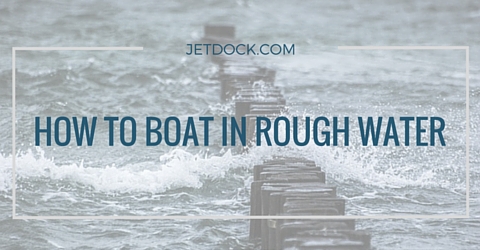For many people, summer means blue skies, sunshine and boating, but with good weather comes the bad. Storms can make water not only difficult to navigate but also extremely dangerous. Don’t get caught on the water in a storm without knowing some rough water boating techniques.

One of the most crucial parts of boating in inclement weather is to follow your emergency plan—but this only works if you have one. Even if the weather forecast predicts blue skies and sunshine all day, there is still a chance the weather could change drastically over the water, and you could find you and your pontoon boat in rough water with very little warning. Think of your bad weather plan as the fire escape route for the water. Ensure you have enough life jackets each time you leave your boat dock. Before you depart, identify who on board has which duties in the event of dangerous weather or large waves. Other useful items to always have on your boat include:
The U.S. National Weather Service (US NWS) will set warnings for wind speed, but these only help if you know what they mean. Marine warnings are broadcasted in knots or a nautical mile. One knot is equivalent to 1.15 mph. Learn the terms the NWS uses to classify wind speed:
These wind warnings directly correlate with the weather warnings broadcasted by the US NWS:
Wind, water currents and barometric pressure can help you not only predict the weather, but understanding these factors can assist you when navigating the water. Higher wind speeds mean stronger currents and bigger waves, and could prove to be the biggest issue you face when rough water boating.
If you really want to know how to drive a boat in rough water, learn to read a barometer. Incoming weather can be identified by the changes in barometric pressure, even before a weather advisory is posted. Take a barometer reading every six hours or so and identify any changes.
If you get caught in a storm, use these tips to help you navigate and identify where the storm is coming from and where it's going:
Not only do thunderstorms create strong winds, large waves and heavy rain, but lightning is also a major threat. No advisories will notify you of the presence or abundance of lightning, so it is imperative to keep an eye on the sky and look for lightning leading up to or during a storm. Lightning can create catastrophic damage to your watercraft as well as result in fires and loss of electricity. If possible, when rough water boating, remain in your boat's cabin until the storm passes and avoid contact with electrical devices.
Avoid sailing through the actual storm if at all possible. You risk the possibility of capsizing, losing electricity, damaging your boat and more. Having a plan of action before leaving your floating boat lift will help you identify possible ports for you and your crew to ride out the storm.
If the waves and rough water are dissociated from a storm, proper training will be your best friend when navigating and driving.
Ask any captain, docking a boat can be one of the most difficult parts of the boating experience, but even more so with unpredictable waves and winds. Investing in floating jet ski docks, floating rough water docks and mooring accessories will help you safely dock your boat in high or rough water. Floating docks with long pilings are ideal for docking your boat or PWC in rough waters as they are able to handle the surges that come with bad weather. However, if you are docking your boat at a floating dock rather than a mooring, secure your ties to the highest part of the piling, as your boat will be more secure than if tied to the floating rough water dock itself. If you are worried about chafing against other boats or docks, reinforce your lines by using ground tackle and anchor your boat down.With the proper preparation, knowledge and training, you will be ready to face rough waters if need be.
Find Your Dock NowBy answering a few quick questions we will be able to tell you which dock or boat lift is the perfect fit for you.
Start Now! ▶